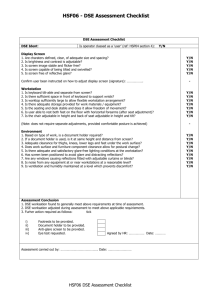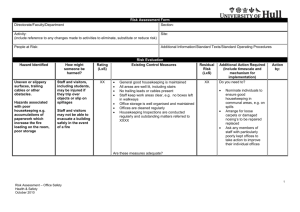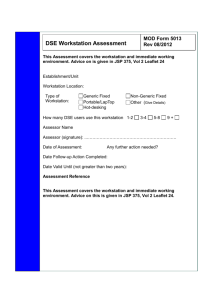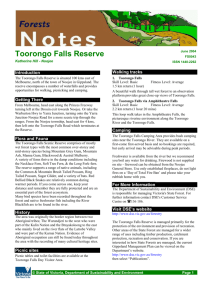MOD form 5016: display screen equipment user risk
advertisement
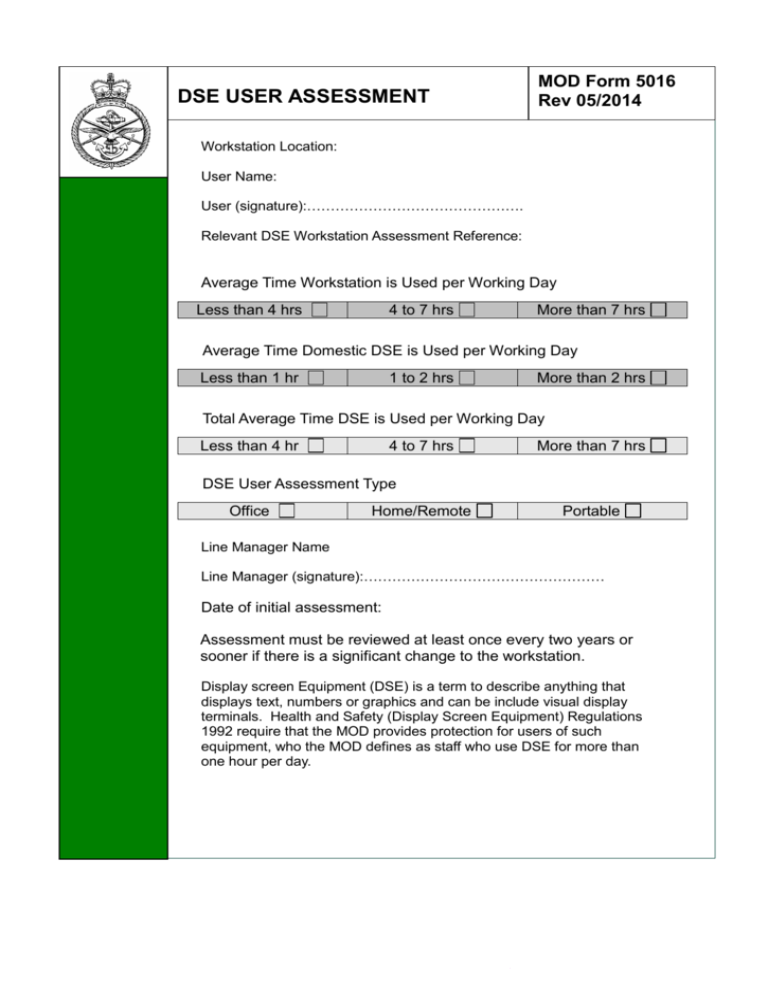
DSE USER ASSESSMENT MOD Form 5016 Rev 05/2014 Workstation Location: User Name: User (signature):………………………………………. Relevant DSE Workstation Assessment Reference: Average Time Workstation is Used per Working Day Less than 4 hrs 4 to 7 hrs More than 7 hrs Average Time Domestic DSE is Used per Working Day Less than 1 hr 1 to 2 hrs More than 2 hrs Total Average Time DSE is Used per Working Day Less than 4 hr 4 to 7 hrs More than 7 hrs DSE User Assessment Type Office Home/Remote Portable Line Manager Name Line Manager (signature):…………………………………………… Date of initial assessment: Assessment must be reviewed at least once every two years or sooner if there is a significant change to the workstation. Display screen Equipment (DSE) is a term to describe anything that displays text, numbers or graphics and can be include visual display terminals. Health and Safety (Display Screen Equipment) Regulations 1992 require that the MOD provides protection for users of such equipment, who the MOD defines as staff who use DSE for more than one hour per day. DSE User Assessment MOD Form 5016 Intro 08/2012 Competency for carrying out DSE User assessments The User DSE assessment will normally be carried out by the user with help from their line manager or DSE assessor as required. Training is provided via the Defence Academy course V397 (DSE). The person undertaking the assessment must have the ability to: identify hazards and assess risks from the workstation and the kind of DSE work being done; draw upon additional sources of advice as appropriate; make a clear record of the assessment and communicate the findings to Line Managers and DSE Users who need to take appropriate action; recognise their own limitations as to assessment so that further expertise can be called on if necessary. The level of training can be tailored to the type of assessment being carried out. For example, home workers may only need to know about the hazards that they are likely to encounter, but may need to know more about how to get support. The selection and training of individuals should reflect the location, complexity of the DSE workstations and novelty of the tasks being carried out, e.g.: Normal/remote office environments – user with basic DSE training. Complex DSE, novel tasks or specific individual requirements – Specialist with advanced assessor training. User Assessment Risk Factor Training 1 Have you undertaken the mandatory DSE user training (Course V397)? 2 Do you know how to use keyboard shortcuts for the software you use? Working Patterns 3 Is it possible to vary your work routine? 4 Are there intensive periods of data manipulation or mouse work? Individual Factors 5 Do you have an existing condition that need to be taken into consideration? 6 7 Can your workstation be adjusted appropriate to your needs? Have you had any eyesight test within the past two years? When Using DSE 8 Are you free from aches and pains in your neck, back shoulder or upper limbs? 9 Are you free of pain when typing? 10 Do you suffer from headaches; sore, tired or dry eyes? Do you have difficulties in focussing on the screen or difficulty in re-focussing when looking away from the screen? Is the chair suitable & the seating position comfortable? (most chairs have time/weight limitations e.g. 16Hrs / 120Kg) Are your feet flat on the floor, without too much pressure from the seat on the backs of the legs? 11 12 13 MOD Form 5016 Things to Consider Course V397 should be completed every 2 years. These can reduce wrist problems by minimising the need to use a mouse. Break the working pattern up with short breaks rather than one long break. Combine the use of shortcut key strokes and the mouse; take regular breaks from the DSE. Existing conditions can be made worse by DSE work and special furniture or a unique assessment may be needed. Can the desk, chair, monitor etc. be set at an appropriate height. It is recommended that eyesight tests are carried out at least every 2 years. Take regular breaks. Check posture, workstation setup and furniture adjustments etc. Check posture; is there adequate space in front of the keyboard and are wrists properly supported. Check humidity & lighting; have eyesight tested. Consider having an eyesight test. Replace/Adjust the chair to provide adequate support (including lumber) and a good posture. Consider using a foot rest or getting the desk height adjusted. Action to Take 14 15 16 Are your forearms horizontal and eyes at roughly the same height as the top of the screen? Does you require training or advice on good keyboard techniques? Adjust the chair and screen. Do you need training in the use of any software or hardware to perform DSE tasks? Software should be user-friendly and minimise stress. Software should respond quickly and clearly to input, with adequate feedback, e.g. clear help messages. Provide/seek advice on good keyboard technique. Additional Comments Flexible workers: If you work away from the main office regularly, work in more than one location or work from home you will need demonstrate to your line managers satisfaction that you know how to set up and assess your own work station and complete the user assessment. Portable DSE users: lap tops and other portable appliances present different risks, as a portable DSE user you need to be aware of the risks associated with this type of equipment and make use of items provided for your wellbeing. You may also be required to demonstrate to your line manager that you know how to set up and assess your own work station and complete the user assessment. The DSE User and Line Manager shall agree what actions are required and record them below. The line manager should check later that the actions taken have resolved the problem. What action has been identified Serial No Action Required Is a specialist DSE Assessment required? Reviewed Reason for review (Date) Actionee Date Completed Have actions required been completed? Is any Action Required? Line Managers Signature If YES complete a new form
